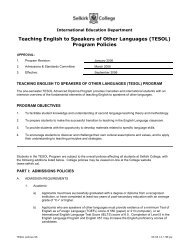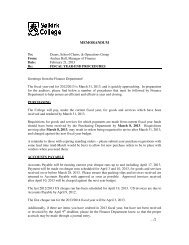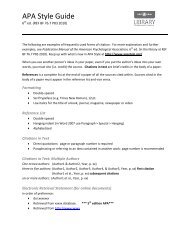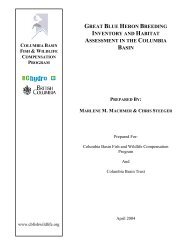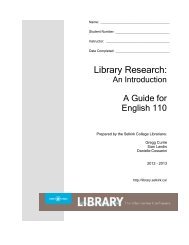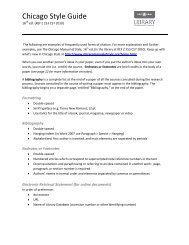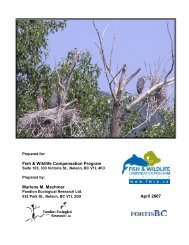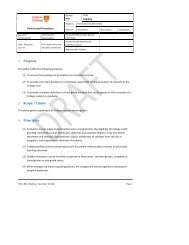selk irk.ca - Selkirk College
selk irk.ca - Selkirk College
selk irk.ca - Selkirk College
Create successful ePaper yourself
Turn your PDF publications into a flip-book with our unique Google optimized e-Paper software.
University Arts and Sciences Course Descriptions<br />
BIOL 200 Principles of Ecology<br />
Ecology is the study of the distribution and<br />
abundance of organisms, and the interactions<br />
that determine distribution and abundance.<br />
This course provides an introduction to the<br />
major principles of ecology. Ecologi<strong>ca</strong>l concepts<br />
are discussed as they apply to individuals,<br />
populations, communities, and ecosystems. Basic<br />
statisti<strong>ca</strong>l methods for ecology are used to analyse<br />
data gathered in field and laboratory experiments.<br />
BIOL 104 and 106 each with a grade of “C”<br />
or better, or written permission of<br />
the Instructor and School Chair.<br />
BIOL 202 Principles of Genetics<br />
This course provides the student with a knowledge<br />
of classi<strong>ca</strong>l and reverse genetics. Topics covered<br />
include Mendelian inheritance, chromosome<br />
theory of heredity, sex determination, mutation,<br />
the structure and function of genes, molecular<br />
genetics, and the genetic structure of populations.<br />
Experimental techniques used in molecular<br />
genetics are also introduced.<br />
BIOL 104 and 106 with a grade of “C” or better,<br />
or written permission of the Instructor<br />
and School Chair.<br />
BIOL 204 Cell Biology<br />
This course provides the student with a thorough<br />
knowledge of cell structure and function. Topics<br />
covered include biomolecules, membranes,<br />
organelles, cell movement, cell signaling, gene<br />
regulation, and transcription and translation.<br />
Experimental techniques used in modern cellular<br />
and molecular biology are also introduced.<br />
BIOL 104 and 106 with a grade of “C” or better,<br />
or written permission of the Instructor<br />
and School Chair.<br />
BIOL 206 Introductory Biochemistry<br />
This course provides an introduction to biochemistry<br />
including protein structure and function, and<br />
representative <strong>ca</strong>tabolic and anabolic pathways.<br />
Topics covered include water, enzyme kinetics<br />
and enzyme structure and function. Experimental<br />
techniques used in biochemistry and molecular<br />
biology are also introduced.<br />
Biology 104 and 106 with a grade of “C” or<br />
better, or written permission of the Instructor<br />
and School Chair.<br />
NOTE: Students are advised to take CHEM<br />
212 as a prerequisite and CHEM 213 concurrently<br />
with BIOL 206.<br />
BIOL 210 Biology of Vascular Plants<br />
This course provides a study of vascular plants<br />
emphasizing anatomy, evolution of structure,<br />
taxonomy, and ecology. Topics include cell and<br />
tissue types, growth and development, basic physiology<br />
and comparative studies of the divisions of<br />
vascular plants. A final <strong>ca</strong>se study of timberline<br />
plants draws the different subject areas together<br />
for a practi<strong>ca</strong>l review. Lab work involves working<br />
with live samples and prepared slides of important<br />
plant tissues, learning how to identify shrubs in<br />
winter, <strong>ca</strong>rrying out a greenhouse experiment, and<br />
participating in a field trip.<br />
Biology 104 and 106 with a grade of “C” or<br />
better.<br />
BIOL 212 Microbiology<br />
This course is a survey of the microbial world,<br />
with discussions of the medi<strong>ca</strong>l and ecologi<strong>ca</strong>l<br />
signifi<strong>ca</strong>nce of key organisms. The biology<br />
of micro-organisms (including bacteria and<br />
viruses) is a key fo<strong>ca</strong>l point, but there will also be<br />
discussions of immunology and pathology. The<br />
laboratory component will build basic skills necessary<br />
to perform and interpret research in the fields<br />
of medi<strong>ca</strong>l microbiology, industrial microbiology,<br />
environmental microbiology, immunology and<br />
virology. A basic knowledge of biology will be<br />
presumed, including basic cell biology, ecology,<br />
physiology, biochemistry and metabolism.<br />
Biology 104 and 106 (or another six credits<br />
of 100-level biology) with a grade of “C”<br />
or better, or written permission from the<br />
instructor and School Chair.<br />
BIOL 214 Vertebrate Morphology<br />
This course provides experience in the functional<br />
and evolutionary analysis of vertebrate structure.<br />
The course is required or recommended in most<br />
degree programs in animal biology, zoology,<br />
conservation biology, environmental biology,<br />
ecology, physiology, and health sciences. The term<br />
vertebrate morphology refers to the structure<br />
of back-boned animals (fish, amphibians,<br />
reptiles, birds, and mammals). The Biology<br />
214 curriculum emphasizes the development of<br />
communi<strong>ca</strong>tion, problem-solving, self-directed<br />
learning, information retrieval, and criti<strong>ca</strong>l thinking<br />
skills. The course includes laboratory, seminar,<br />
investigative, report-based, and problem-based<br />
learning exercises.<br />
Biology 104 and 106 with a grade of “C” or<br />
better.<br />
BIOL 220 Investigations in Biology<br />
A field or laboratory project course taught<br />
cooperatively by department faculty and some<br />
community agencies. Data collection, report<br />
writing, seminar presentation, and lab analyti<strong>ca</strong>l<br />
procedures will be taught as required to <strong>ca</strong>rry out<br />
an approved project. For university second year<br />
unassigned credit.<br />
BIOL 104 and 106, and prior completion of<br />
at least one second year Biology course and<br />
a grade point average of 2.5 or better.<br />
Chemistry<br />
CHEM 050 Basic Principles of Chemistry<br />
This introductory course is designed to be<br />
equivalent to Chemistry 11 at the high-school<br />
level. Chemistry is introduced as a experimental<br />
science. Chemi<strong>ca</strong>l symbols, nomenclature and<br />
the quantitative aspects of chemi<strong>ca</strong>l reactions are<br />
emphasized. The fundamentals of classi<strong>ca</strong>l atomic<br />
and molecular structure are presented. The field<br />
of organic chemistry is briefly introduced. The<br />
laboratory experiments provide opportunities<br />
to work with standard labware and apparatus,<br />
to observe a variety of chemi<strong>ca</strong>l reactions and to<br />
<strong>ca</strong>rry out some quantitative measurements.<br />
Math 49; Math 050 should be taken<br />
concurrently.<br />
CHEM 110 Fundamentals of Chemistry<br />
This introductory general chemistry course leads<br />
into science or engineering programs for students<br />
who have taken Chemistry 11 (or equivalent)<br />
or who need improvement to their chemistry<br />
background. It provides an extensive review of the<br />
fundamentals of chemi<strong>ca</strong>l nomenclature, reactions<br />
and stoichiometry involving solids, gases and solutions.<br />
Current theories of atomic and molecular<br />
structure are introduced. The lab portion of this<br />
course is the same as CHEM 122.<br />
CHEM 11 or CHEM 050, and Principles of<br />
MATH 11 or Math 050. Principles of Math 12<br />
or Math 051 is recommended. Each course<br />
must have a grade of “C” or better.<br />
CHEM 122 General Chemistry I<br />
This introductory general chemistry course leads<br />
into science or engineering programs for students<br />
who have a solid chemistry background, including<br />
Chemistry 12 or equivalent. After a short review<br />
of fundamental chemistry, classi<strong>ca</strong>l and quantum<br />
mechani<strong>ca</strong>l concepts are used to discuss atomic<br />
and molecular structure. The lab work stresses<br />
scientific observations and measurements using<br />
chemi<strong>ca</strong>l syntheses and quantitative analyses.<br />
CHEM 12 or CHEM 110, and Principles of<br />
MATH 11 or Math 050. Principles of Math 12<br />
or Math 051 is recommended. Each course<br />
must have a grade of grade of “C” or better.<br />
CHEM 125 Foundations of Chemistry II<br />
This general chemistry course is the continuation<br />
of either Chemistry 110 or Chemistry 122.<br />
Chemistry 125: Foundations of Chemistry II<br />
begins with an investigation of intermolecular<br />
forces in liquids and solids, followed by the<br />
colligative properties of solutions. Next, it presents<br />
the principles of equilibria applied to pure<br />
substances and aqueous solutions of acids, bases<br />
and salts. The laws of thermodynamics applied to<br />
chemi<strong>ca</strong>l substances are introduced. The field of<br />
School of University Arts and Sciences<br />
Selk<strong>irk</strong> <strong>College</strong> 12/13<br />
205




